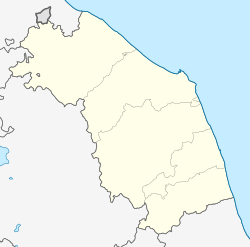|
Acquaviva Picena
Wikimedia Commons has media related to Acquaviva Picena.  Acquaviva Picena is a comune (municipality) in the Province of Ascoli Piceno in the Italian region Marche. The village lies on a hill overlooking the Valley of Tronto, just a few kilometres from the Adriatic Sea and San Benedetto del Tronto. From the top of the hill (365 m.s.l.), it’s possible to see the Sibillini Mountains (Monte Vettore), and even farther away Gran Sasso and Majella. HistoryThe Acquaviva area has been inhabited since prehistory, proof of that are several archaeological finds, most of which are from the Piceno age, but also from the Roman Age. When the Picentes (or Piceni, Italian), who settled here during the 6th century B.C., were subdued by Roman forces, the village of Acquaviva survived thanks to the closeness to Castrum Truentinum. During the Barbarian Invasions the village grew into an urban settlement: the coming of Lombards and Saracens forced the coastal population to move inland. The village was originally owned by the Farfa Abbey (947), then became a feudal holding of the Acquaviva family (hence the name) who built the fortress during the 13th century. In 1341 Acquaviva fell under control of the city of Fermo and became a garrison against enemy territory, keeping coastal villages (San Benedetto in Albula) out of the reach of Ascoli. During the 15th century the village's population grew, bringing its numbers to twice its original size. The eastern section of the village was built and named “Terra nuova” to distinguish it from “Terra vecchia” which was the original settlement, just before the fortress. That made it necessary to build another section of the fortress on the same side, to its east. As part of the Papal States, Acquaviva was annexed with a plebiscite vote to the Kingdom of Italy in 1860. Main sights
CultureEvents in the town include:
References
External linksWikimedia Commons has media related to Acquaviva Picena. |
||||||||||||||||||||||||||||||||||||||||||||||||||||||



